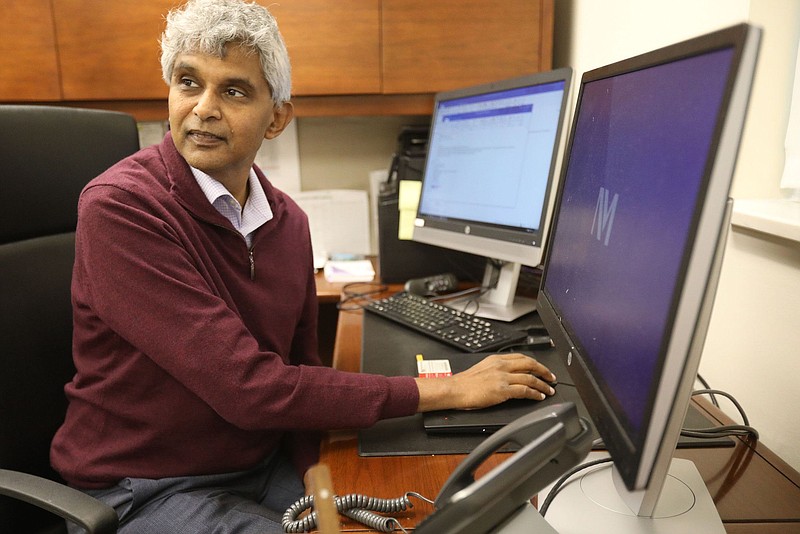CHICAGO - As a medical provider, Dr. Mahesh Ramachandran encouraged his patients to keep working as hard as they could in physical therapy, knowing more effort could yield more results.
But then, he became a patient himself. And it left him with a new appreciation for the neurological work the patients put in every day as part of their rehabilitation.
Ramachandran, the chief medical officer of Marianjoy Rehabilitation Hospital in Wheaton, Illinois, landed in recovery there after suffering a stroke over Memorial Day weekend.
It caused weakness to his left side, leaving him in need of therapy to help relearn things like getting dressed.
"I had a very hard time buttoning a shirt, putting on a belt," he said. "Tying shoelaces were pretty much impossible for me to do on my own. Day-to-day simple things like that, because you use both your hands for those tasks."
After stumbling in his backyard in May and feeling a bit confused, Ramachandran went inside. About half an hour later, he noticed his left arm felt weak. He grew alarmed and asked his wife to call 911.
As a stroke specialist, he knows what feeling weak on one side could mean. And he also knew speed mattered; by getting to the hospital quickly, he was able to be diagnosed and begin care.
Doctors told him he'd had a stroke on the right side of his brain. "Fortunately, it didn't affect my speech, my cognition," Ramachandran said.
But he still had a journey ahead.
He hoped to do outpatient therapy, coming to Marianjoy for appointments and sleeping at home. But it quickly became clear he would need to stay at the hospital, as he had difficulties walking and worried about his wife needing to lift and carry him at home.
Coming in as a patient through the doors of Marianjoy he'd so often entered as chief medical officer "was a completely different perspective," he said.
On a scientific level, he was familiar with the kind of stroke he'd had. "I felt very good about my chances of recovery," he said.
He noted many people assume all strokes are the same, but they vary in location, intensity and recovery.
A stroke happens when blood supply to part of the brain is interrupted, preventing the brain from getting oxygen or nutrients. According to the Mayo Clinic, symptoms include trouble speaking or understanding others, paralysis or numbness of the face, arm or leg, headache or problems seeing in one or both eyes. Getting care quickly is key.
Despite Ramachandran's wealth of scientific knowledge about his body, the experience was still difficult for him.
"The actual going through the symptoms and the therapy and being a patient was quite eye-opening," he said.
His neurological recovery included physical therapy to strengthen muscles and improve balance, occupational therapy to relearn things like picking up cups, and speech therapy, where a therapist checked things like swallowing and speech production.
Ramachandran remembers an exercise he found difficult - a type of video game where patients used one hand to maneuver a joystick.
"Initially I had a very hard time moving objects," he said. "After 10 to 15 seconds, I would just be exhausted, and my left arm would not move anymore." Eventually he worked his way up to minutes at a time.
During frustrations and victories alike, he also saw a new side of his staff as one of their patients, he said, making him feel "both happy and proud to be part of the program."
One of the big things he learned was how much of a barrier fatigue can be.
"It takes a lot more energy, because of the weakness you have on one side of the body, to do simple activities," he said. "One of the things that I realized is that even though studies show the more therapy you do, the better you get, your body also needs to rest. It's probably not something that I realized as much as a physician."
By August, he had returned to work full time. And his work feels different. He knows he will remember that fatigue and balance that memory with his urge to motivate his patients.
"That's kind of a change in my practice, that I'll say: You need to work hard, but you also need to get that rest so your body can recharge," he said.
Ramachandran also gained a new appreciation for how family and friends support sick relatives, and the mental aspect of recovering from a stroke.
"This is a life-altering event, so the emotional and psychological aspects of it are tremendous, because they don't know if they can return back to their way of living. Can they go back to work? Can they go back to driving? And so on," he said.
And, for the first time, he can tell those he treats how he, too, has been at Marianjoy as a patient. He hopes encouragement to keep going will hold more weight.
"I think sometimes if you just say that as a physician, it may not have the impact that I can have now," he said.
Ramachandran can tell patients, "I've lived through it."

